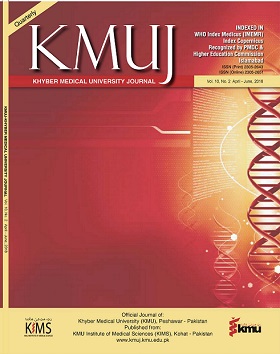EVALUATION OF SERUM URIC ACID LEVELS IN PATIENTS WITH PRIMARY THYROID DYSFUNCTION
Main Article Content
Abstract
ABSTRACT
OBJECTIVE: To evaluate the levels of serum uric acid in the patients with primary thyroid dysfunction
METHODS: This cross-sectional study was carried out at Military Hospital (MH) Rawalpindi, Pakistan from July-December 2014 after obtaining the ethical and institutional permission. A total of sixty patients of both genders and newly diagnosed with primary thyroid dysfunction were recruited. Informed written consent was obtained from each participant. Patients were categorized in primary hyperthyroid (serum TSH <0.40 mIU/L and elevated fT4) and primary hypothyroid (serum TSH >4.50 mIU/L and reduced fT4) groups. Serum uric acid levels of both groups were estimated and levels >420 µmol/L in males and >360 µmol/L in females were labeled as hyperuricemia. Results were entered and analyzed through SPSS version 21.
RESULTS: Out of sixty participants, 21 (35%) patients were male while 39 (65%) patients were females and mean age was 42.31±11.27 years. Primary hypothyroidism group consisted of 43 (71.7%) patients while 17 (28.3%) patients were in primary hyperthyroidism group. Elevated serum uric acid levels were present in 65% patients (n=39). In the patients with hypothyroidism, 31 out of 43 (72%) patients were diagnosed with hyperuricemia while the corresponding numbers in hyperthyroid group were 8 out of 17 (47%). However, difference among mean Serum uric acid levels of both groups was insignificant (385.27±182 µmol/L and 316.95±169 µmol/L, p>0.01).
CONCLUSION: Patients with primary thyroid dysfunction have elevated serum uric acid levels that are more frequent in primary hypothyroidism as compared to primary hyperthyroidism.
KEY WORDS: Endocrine System Diseases (MeSH); Hyperuricemia (MeSH); Hypothyroidism (MeSH); Primary Hyperthyroidism (MeSH); Thyroid Diseases (MeSH); Uric Acid (MeSH).
Article Details
Work published in KMUJ is licensed under a
Creative Commons Attribution 4.0 License
Authors are permitted and encouraged to post their work online (e.g., in institutional repositories or on their website) prior to and during the submission process, as it can lead to productive exchanges, as well as earlier and greater citation of published work.
(e.g., in institutional repositories or on their website) prior to and during the submission process, as it can lead to productive exchanges, as well as earlier and greater citation of published work.
References
REFERENCES
Zimmermann MB, Jooste PL, Pandav CS. Iodine-deficiency disorders. Lancet 2008 Oct 4;372(9645):1251-62. DOI: 10.1016/S0140-6736(08)61005-3.
Bassett JH, Williams GR. Role of thyroid hormones in skeletal development and bone maintenance. Endocr Rev 2016;37(2):135-87. DOI: 10.1210/er.2015-1106.
Duntas LH, Brenta G. The effect of thyroid disorders on lipid levels and metabolism. Med Clin North Am 2012;96(2):269-81. DOI: 10.1016/j.mcna.2012.01.012.
Rodrigues SL, Baldo MP, Capingana P, Magalhães P, Dantas EM, Molina Mdel C, et al. Gender distribution of serum uric acid and cardiovascular risk factors: population based study. Arq Bras Cardiol 2012;98(1):13-21.
Abeles AM. Hyperuricemia, gout, and cardiovascular disease: an update. Curr Rheumatol Rep 2015;17(3):13. DOI: 10.1007/s11926-015-0495-2.
Ahsan N, Zuberi NA, Alam SM, Effendi JS, Tunio SA. Association of high serum uric acid with risk factors of cardiovascular disease in the rheumatology clinic of a tertiary care hospital of Karachi. Ann Abbasi Shaheed Hosp Karachi Med Dent Coll 2014;19(1):10-4.
Fang J, Alderman MH. Serum uric acid and cardiovascular mortality the NHANES I epidemiologic follow-up study, 1971-1992. National Health and Nutrition Examination Survey. JAMA 2000;283(18):2404-10.
Giordano N, Santacroce C, Mattii G, Geraci S, Amendola A, Gennari C. Hyperuricemia and gout in thyroid endocrine disorders. Clin Exp Rheumatol 2001;19(6):661-5
Zhang J, Meng Z, Zhang Q, Liu L, Song K, Tan J, et al. Gender impact on the correlations between subclinical thyroid dysfunction and hyperuricemia in Chinese. Clin Rheumatol 2016;35(1):143-9. DOI: 10.1007/s10067-015-2867-4.
Ye Y, Gai X, Xie H, Jiao L, Zhang S. Association between serum free thyroxine (FT4) and uric acid levels in populations without overt thyroid dysfunction. Ann Clin Lab Sci 2015;45(1):49-53
Raber W, Vukovich T, Vierhapper H. Serum uric acid concentration and thyroid-stimulating-hormone (TSH): results of screening for hyperuricaemia in 2359 consecutive patients with various degrees of thyroid dysfunction. Wien Klin Wochenschr 1999;111(8):326-8
See LC, Kuo CF, Yu KH, Luo SF, Chou IJ, Ko YS, et al. Hyperthyroid and hypothyroid status was strongly associated with gout and weakly associated with hyperuricaemia. PloS One 2014;9(12):e114579. DOI: 10.1371/journal.pone.0114579
Khan AH, Majumder I. Serum creatinine and uric acid levels of hypothyroid patients. Bangladesh J Med Biochem 2013;3(2):61-63.
de Oliveira EP, Burini RC. High plasma uric acid concentration: causes and consequences. Diabetol Metab Syndr 2012;4(4):4-12. DOI: 10.1186/1758-5996-4-12
Doghramji PP, Wortmann RL. Hyperuricemia and gout: new concepts in diagnosis and management. Postgrad Med 2012;124(6):98-109. DOI: 10.3810/pgm.2012.11.2616
Wedaatalla MA, Abdella AM. Assessment of plasma Uric acid Level among Sudanese Female with Thyroid Dysfunction. Sudan J Public Health 2012;7(3):89-92.
Yokogoshi Y, Saito S. Abnormal serum uric acid level in endocrine disorders. Nihon Rinsho 1996;54(12):3360-3
Khan MAH, Majumder MI, Hoque MM, Fariduddin M, Mollah FH, Arslan I. Serum Creatinine and Uric Acid Levels in Hypothyroid Patients: A Cross Sectional Study. J Enam Med Coll 2013;3(2):84-7
Abebe N, Kebede T, Wolde M. Assessment of renal function and electrolytes in patients with thyroid dysfunction in Addis Ababa, Ethiopia: a cross sectional study. Pan Afr Med J 2016;24:338. DOI: 10.11604/pamj.2016.24.338.8455.
Sidhu GK, Malek RR, Khubchandani A, Mansuri SH, Patel MS, Oza RH. A study of serum urea, creatinine and uric acid levels in hypothyroid patients. Int J Res Med 2016;5(2):115-8.
Dariyerli N, Andican G, Catakoglu AB, Hatemi H, Burcak G. Hyperuricemia in hypothyroidism: is it associated with post-insulin infusion glycemic response? Tohoku J Exp Med 2003;199(2):59-68.
Tayal D, Chawla R, Arora S, Gupta VK, Sohi JS, Mallika V. Dynamic changes in biochemical markers of renal function with thyroid status-A study in Indian population. Internet J Med Update 2009;4(2):36-41. DOI: 10.4314/ijmu.v4i2.43842
